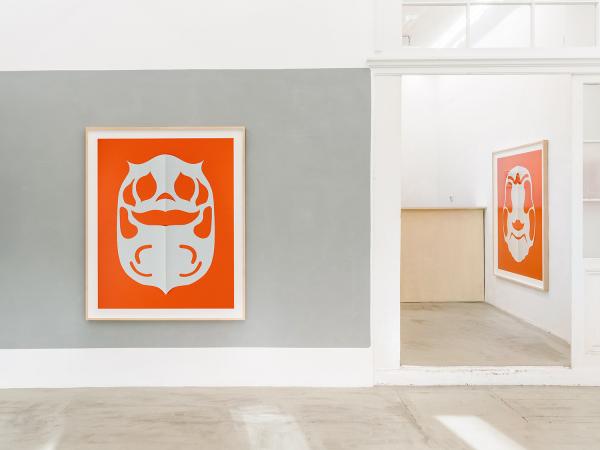I only know Mifune and Kitano, 2020
153 x 128 cm
Edition 2 + 1 A.P.
40 x 33 cm
Edition 5 + 1 A.P.
D:
Die Serie „I only know Mifune and Kitano" von Matthias Klos ist eine Auseinandersetzung mit der Wirkung von kulturellen Klischees: Persönliche Assoziationen wie Handwerk, Papier, Manga, Samurai, Mifune und Kitano ergaben zusammen ein „Japan-Gefühl", der Scherenschnitt erschien als geeignetes Medium des künstlerischen Übertrags. Mit hohem Präzisionsanspruch intuitiv ohne Vorzeichnung in einem einzigen durchgehenden, konzentrierten Arbeitszug angefertigt, entstanden entlang der gefalteten Mittelachse gespiegelte Muster, die zwischen ornamentaler Abstraktheit und maskenhafter Silhouette changieren. Vom Künstler als Piktogramme einer selbstreferenziellen Kulturikonografie gedacht, haben sie privaten Charakter, deren Informationsgehalt nur indirekt übersetzt werden kann. Sie leiten sich ab vom Japan des Kinos, des gefalteten Papiers und der Comics, kurz: von den kulturellen Exportgütern, die uns etwas von einem Land erzählen, auch wenn wir nie dort gewesen sind. Im Titel verweist der Künstler mit schonungslosem Witz auf das eigene (Nicht-)Wissen, das sich aus Unterhaltungsindustrie und Populärkultur, aus Fiktionen und Überlieferungen speist, aber auch von ethnologischem Interesse geleitet wird und sich letztlich auf die eigene Erfahrung aus zweiter Hand richtet. Gleichzeitig sind ästhetische Objekte entstanden, die an eine künstlerische Tradition des geschnittenen Papiers anknüpfen, welche vor Jahrhunderten u.a. aus dem asiatischen Raum nach Europa gelangte und einen Kulturübertragungsprozess durchlaufen hat. Lange Zeit als weibliche Handarbeit oder Kunststück fahrender Gaukler betrachtet und erst mit der Moderne als kunstwürdig anerkannt, vollzieht der Scherenschnitt als Weise des Zeichnens am Papier die Trennlinie buchstäblich, die als Markierung der Grenze zwischen einer Figur und ihrem Hintergrund fungiert und ihre Wahrnehmbarkeit bedingt. Die Scherenschnitte von Matthias Klos haben auf farbigem Karton fotografiert im Print unterschiedliche Größen, die ihre Formen überdimensional erscheinen lassen. Mit der gerahmten, fotografischen Abbildung nimmt der Künstler einen medialen Transfer der Papierobjekte vor, die ihre piktorale Ästhetik hervorkehren.
Text: Synne Genzmer
E:
In the series "I only know Mifune and Kitano" Matthias Klos explores the effect of cultural clichés: personal associations such as crafts, paper, manga, samurai, Mifune and Kitano come together to evoke a "feeling of Japan" for which silhouettes seem to be a suitable medium of artistic communication. Drawn intuitively without preliminary sketches in a single continuous, concentrated step requiring high precision, they are mirror-image patterns created along the folded middle axis that fluctuate between ornamental abstraction and mask-like silhouette. Conceptualized by the artist as pictograms of a self-referential cultural iconography, they have a private character whose informational content can only be indirectly translated. They are derived from the Japan of cinema, of origami and comics, in short: from the cultural exports that tell us something about a country even if we've never been there. In the title, the artist mercilessly mocks his own (lack of) knowledge, which comes from the entertainment industry and popular culture, fiction and lore, but is also guided by ethnological interest and ultimately based on his own second-hand experience. At the same time, they are aesthetic objects that borrow from an artistic tradition of paper cutting that reached Europe centuries ago from Asia (among other places) and underwent a process of cultural transmission. Long regarded as a women's craft or traveling artists' work and only granted the status of art in modern times, the silhouette as a method of drawing on paper literally brings to completion the dividing line that marks the border between a figure and its background and allows it to be perceived. Matthias Klos' silhouettes, photographed on colored cardboard, have different sizes in the print that make their shapes seem inordinately large. With the framed, photographic image, the artist carries out a media transfer of the paper objects, emphasizing their pictorial aesthetics.
Text: Synne Genzmer






